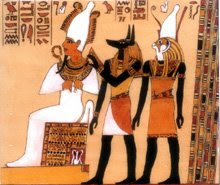Israel strayed into the same practices as their neighbors, though their prophets strove mightily to curb that idolatry.
"And they left all the commandments of the Lord their God, and made them molten images, even two calves, and made a grove, and worshipped all the host of heaven, and served Baal." (2 Kings 17:16, italics added.)
King Josiah attempted to "put down the idolatrous priests, whom the kings of Judah had ordained to burn incense in the high places in the cities of Judah, and in the places round about Jerusalem; them also that burned incense unto Baal, to the sun, and to the moon, and to the planets, and to all the host of heaven." (ibid. 23:5, italics added.)
Clearly this "host" or group was not comprised of God and his angels, and the heaven spoken of is not God's residence. The prophets referred to astral or cosmological bodies, as is specifically stated: the sun, moon, planets and stars. And the heaven spoken of is the vault of the sky over the Earth where all such astral bodies reside. This concept is key to understanding the meaning of the prophets.
Pay particular attention to the fact that planets are listed, along with the sun and the moon, among the things designated as the "host of heaven." Note that calves, cows and bulls were intrinsic symbols employed in their worship and the implication long recognized by scholars that Baal was an astral or cosmological deity.
Likewise, illustrations of the Egyptian goddess Hathor always depict her either as a cow with what is called a "sun disk" between her horns or as a queen wearing a disk and horns on her head.
In fact, it was the worship of astral images that the Lord, speaking through Moses, condemned "… lest thou lift up thine eyes unto heaven, and when thou seest the sun, and the moon, and the stars, even all the host of heaven, shouldest be driven to worship them, and serve them …." (Deuteronomy 4:19.)
So, the Israelites worshipped the stars and the planets in identical fashion to their neighbors the Babylonians, the Assyrians and the Egyptians. Scholars who study antiquity have long asserted this.
Joseph Smith, too, emphasized that the Egyptians’ gods represented "planets" and "stars" when he produced his explanations of his Egyptian papyri. It is no great leap of logic, therefore, to assume that the language of the prophets, immersed in Israelite culture, reflected that astral worship — reverence for the stars, moon, sun and planets — even though they condemned the practices associated with it.
So it is that when we turn to the scriptures, we see an abundance of such cosmological imagery in prophetic declarations — especially those concerning the last days. Tellingly, the same imagery can be found in other biblical pronouncements, illuminating their origins for us.
Let’s look at just one example.
"And there appeared a great wonder in heaven; a woman clothed with the sun, and the moon under her feet, and upon her head a crown of twelve stars." (Revelation 12:1.)
This 'woman,' described by John, is the same 'woman' worshipped by the idolatrous Israelites, their Queen of Heaven.
"But we will certainly do whatsoever thing goeth forth out of our own mouth, to burn incense unto the queen of heaven, and to pour out drink offerings unto her, as we have done, we, and our fathers, our kings, and our princes, in the cities of Judah, and in the streets of Jerusalem …." (Jeremiah 44:17.)
Sumerians also called their sky goddess, Inanna, the "Queen of Heaven." She was the Babylonians’ Ishtar, the Assyrians’ Astarte and the Egyptians’ Hathor (Athyr), Isis, or Sekhmet.
Of particular importance is that the very names of this goddess, Astarte, Ishtar and Athyr (the ‘s’ is aspirated), have the same root as our word ‘star,’ betraying their astral origin. They were all 'star' goddesses.
More familiar names for the same star goddess would include the Greek Aphrodite, Athena, and Artemis, or the Latin Venus, Minerva, and Diana.
As we learned in the previous installment in this series, Joseph Smith indicated that such symbols are representations. "When the prophets speak of seeing beasts [a woman in this case] in their visions, they mean that they saw the images, they being types to represent certain things." (History of the Church, p. 343.)
In the case of the Egyptian papyri, Joseph explained that those images that did not represent some spiritual concept such as God or the priesthood, instead represented stars and planets.
This is key. Like most Egyptian icons, the woman represents a star or a planet. Of course, in the ancient mind, both words can apply to the same image in the sky because they looked alike, mere pinpoints of light. But the archetype, the original image for these goddesses, was a planet. Joseph was emphatic about that.
Yet another connection is provided by the fact that Hathor, who nearly all scholars agree represented the planet Venus, was a celestial calf or heifer — the very same calf goddess worshipped by idolatrous Israelites, as we have seen. This lets us look at the woman of Revelation with new eyes. Substitute the word 'planet' for 'woman,' in the above verse, and you have a more relevant, understandable image that fits better with the sun, moon and stars imagery.
The same kinds of connections can be made for nearly all prophetic images, such as the beasts, the mountain, the kings, horses and other creatures, further strengthening this assessment.
© Anthony E. Larson, 2004


